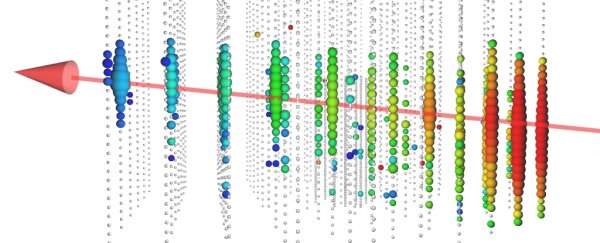When a single neutrino was detected by a neutrino detector in Antarctica in September 2017, it was the start of something amazing. It was to become the first-ever high-energy neutrino that astronomers could trace back to an origin - a blazar galaxy called TXS 0506+056, 3.8 billion light-years away.
But, in the manner of many great discoveries, that revelation opened up a whole new can of questions, including this: why, of all the galaxies with similar properties, has a neutrino only ever been traced to this one?
Now, astronomers have found a possible answer, pinpointing the source event that produced this neutrino. The relativistic jet blasting out of a supermassive black hole could have acted as a cosmic particle collider, producing a flurry of neutrinos that, due to the shape and wobble of the jet, ended up streaming through Earth.
And this could be a signpost indicating the presence of a binary supermassive black hole at the centre of TXS 0506+056 - thought to be the end result of two galaxies merging.
Neutrinos are slippery little suckers. They are among the most abundant subatomic particles in the Universe, a bit similar to electrons, but they don't carry a charge and are almost massless. And they rarely interact with… anything. Trillions are streaming through your body at any given moment.
Because they don't interact with stuff much, we don't detect them very often. When they do interact with the ice below the surface of Antarctica, neutrinos can produce a small shower of particles. In turn, these produce the luminal boom of Cherenkov radiation - this is detected by Cherenkov detectors stationed at the IceCube Neutrino Observatory.
But that's just the detection part.
Tracking a neutrino's trajectory is another challenge altogether, and it took multi-messenger astronomy to accomplish this for the first time last year. That's why we know this particular neutrino - titled IceCube-170922A - came from a blazar, a type of galaxy with an active supermassive black hole oriented so its jet is pointing directly at us.
It seems reasonable to conclude, therefore, that blazars are a source of neutrinos. But there's just one problem. TXS 0506+056 is the only blazar to which neutrinos have been traced.
So, an international team of astronomers led by Silke Britzen from the Max Planck Institute for Radio Astronomy in Germany set out to investigate why.
"We wanted to unravel what makes TXS 0506+056 special, to understand the neutrino creation process and to localise the emission site and studied a series of high resolution radio images of the jet," Britzen said.
The team reanalysed a series of observations taken by the Very Long Baseline Array between 2009 and 2018, studying the jet kinematics and flux-density evolution of individual jet components closely. They paid special attention to 2014 and 2015, a period that saw higher neutrino activity; and also the period before and after the detection of IceCube-170922A.
They found that the dynamics of the jet were not smooth and undisturbed, as is expected. Instead, parts of the jet seemed to be colliding with other parts of the jet.
That could be produced in a number of ways. It could be the result of a new jet slamming into an old one; two jets from different sources; or the clash of two jets from the same source. Whatever it was, the team identified flux-density flaring in six parts of the jet near the likely collision site, which seems to support their hypothesis.
It was this collision, the team believes, that produced IceCube-170922A.
"This collision of jetted material is currently the only viable mechanism which can explain the neutrino detection from this source," said astrophysicist Markus Böttcher of North-West University in South Africa.
"It also provides us with important insight into the jet material and solves a long-standing question whether jets are leptonic, consisting of electrons and positrons, or hadronic, consisting of electrons and protons, or a combination of both. At least part of the jet material has to be hadronic - otherwise, we would not have detected the neutrino."
The team also found that the jet is likely curved; and that the black hole seems to be wobbling, resulting in a precession of the jet, like a wobbling spinning top. Whether it's another black hole or something else creating that wobble is not clear. However, another supermassive black hole in a binary system could produce a second jet.
"The closer we look at the jet sources the more complicated the internal structure and jet dynamics appears," said astronomer Christian Fendt of the Max Planck Institute for Astronomy.
"While binary black holes produce a more complex outflow structure, their existence is naturally expected from the cosmological models of galaxy formation by galaxy mergers."
Well, one thing seems clear: TXS 0506+056 is not like all the other blazars. It may have a binary supermassive black hole at its core. And if the team is correct about the source of the neutrino, future events could reveal more about this bizarre galaxy.
The research has been published in Astronomy & Astrophysics.
